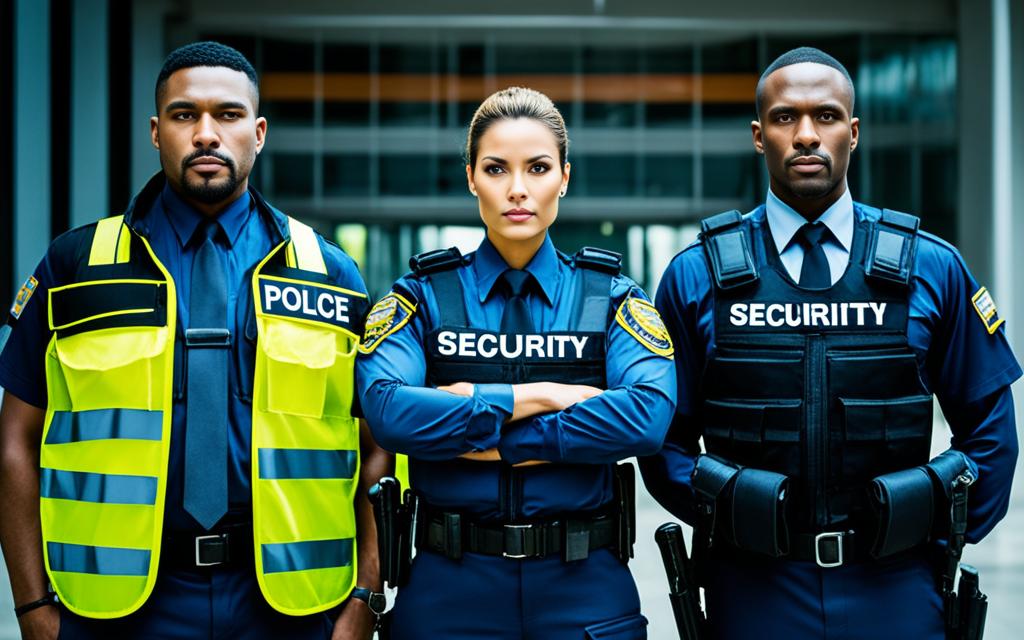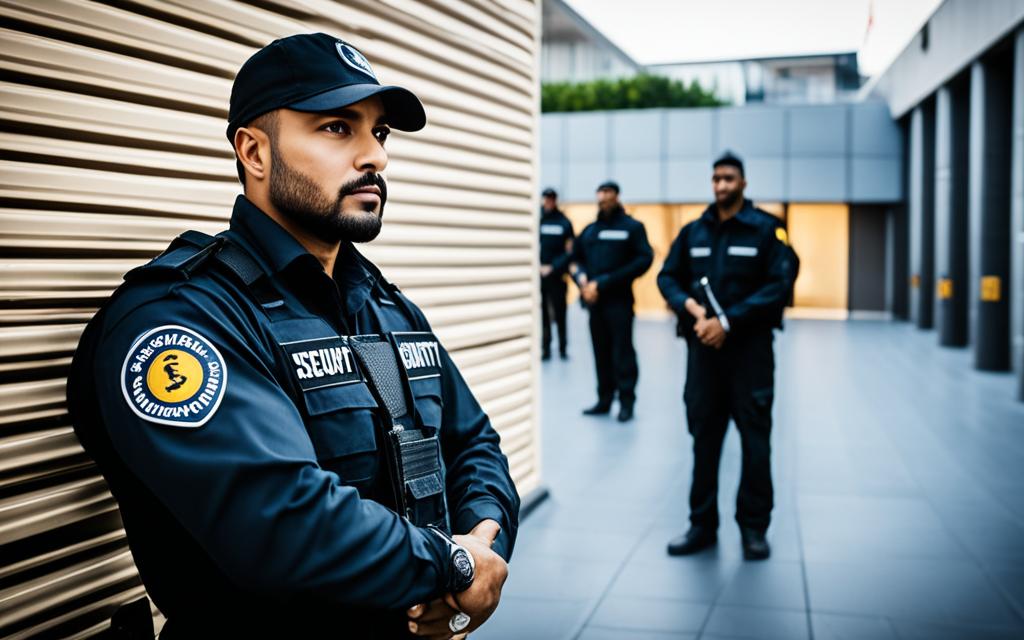In the field of security, there are four distinct levels of security guards, each with its own hierarchy and set of responsibilities. Whether you’re considering a career in security or simply interested in understanding the different roles within this profession, it’s important to grasp the varying levels and their respective duties.
Starting at the entry-level, we have the watchman, followed by the security guard, unarmed security officer, armed security officer, public safety officer, senior security officer, sergeant, corporal, lieutenant, captain or director, and finally the commander or chief.
The hierarchy progresses from the basic watchman position to the highest-ranking role of commander or chief, with each level carrying increasing responsibilities and expectations.
Entry-level security positions, such as watchmen and security guards, have fewer requirements and typically do not involve carrying firearms. On the other hand, armed security officers, public safety officers, and higher-ranking personnel undergo extensive training and may be authorized to carry firearms. These elite forces are equipped with specialized skills to handle various security situations.
Understanding the four levels of security guards provides insight into the levels of training, qualifications, and responsibilities required for different positions within the security industry. This knowledge can help individuals interested in a security career navigate their path and make informed decisions about their training and development.
Key Takeaways:
- The security guard profession comprises four distinct levels with varying responsibilities and requirements.
- The hierarchy ranges from entry-level positions like watchmen and security guards to higher-ranking roles such as armed security officers and chiefs.
- Higher-level positions may involve firearms training, while lower-level roles focus on basic security duties.
- Each level of security guard requires specific qualifications and training.
- Understanding the different levels helps individuals choose a suitable career path and pursue the necessary training.
Unarmed Security Guards
Unarmed security guards play a crucial role in maintaining safety and security in various settings. While they may not carry firearms, they still have important duties and responsibilities to fulfill. Let’s explore the training requirements, duties, and self-defense options available to unarmed security guards.
Training Requirement
Unlike their armed counterparts, unarmed security guards have a lower training requirement. However, this doesn’t diminish the importance of their training. To become an unarmed security officer, individuals typically need to complete around 80 hours of training, which covers essential topics such as emergency response, effective communication, and basic self-defense techniques. This training equips them with the necessary knowledge and skills to handle various security situations.
Duties
Unarmed security guards have a broad range of duties depending on their specific position within the hierarchy. Here are three common rankings within this category:
- Watchman: A watchman is an entry-level position. They perform basic security tasks, such as monitoring surveillance systems, patrolling designated areas, and reporting any suspicious activities or incidents.
- Security Guard: Security guards have a more comprehensive set of responsibilities. In addition to the duties of a watchman, they may also assess security risks, enforce access control procedures, handle visitor inquiries, and provide assistance during emergency situations.
- Unarmed Security Officer: An unarmed security officer is an entry-level position that requires more extensive training. Apart from the duties mentioned above, they can carry self-defense weapons, such as batons or pepper spray, for added protection. They may be assigned tasks such as crowd control, responding to incidents, and ensuring the safety of individuals and property within their jurisdiction.
Self-Defense Weapons
While unarmed security guards do not carry firearms, they can carry self-defense weapons that are non-lethal and less lethal in nature. These tools help them protect themselves and others in potentially dangerous situations. Some common self-defense weapons include:
- Baton: A baton is a collapsible rod that can be used for striking or blocking an attacker. It provides unarmed security officers with a means of defense, allowing them to subdue aggressive individuals without causing serious harm.
- Pepper Spray: Pepper spray is a non-lethal aerosol spray that contains chemicals derived from chili peppers. When sprayed in the face of an attacker, it causes temporary blindness, difficulty breathing, and intense discomfort, allowing security officers to neutralize the threat and gain control of the situation.
- Flashlight stun gun: A flashlight stun gun combines the functions of a regular flashlight and a stun gun. It emits a bright light to illuminate dark areas and can also deliver an electric shock to immobilize an aggressor temporarily.
These self-defense weapons serve as valuable tools for unarmed security guards, ensuring their safety and enhancing their ability to protect the premises they are assigned to.
Unarmed security guards play a vital role in maintaining security and ensuring the safety of individuals and property. Despite not carrying firearms, they receive thorough training and can utilize self-defense weapons to effectively handle various security situations. Their contributions are indispensable in safeguarding the well-being and tranquility of the environments they serve.
Armed Security Guard Rankings
Armed security guards hold a higher level of responsibility and undergo specialized training to carry firearms. Within this level, there are four different rankings, each with its own set of responsibilities and qualifications.
Armed Security Officer
An armed security officer is trained in the use of firearms and has similar responsibilities to an unarmed security officer, but with the added capability of carrying and potentially using a firearm for protection. They are responsible for maintaining a safe and secure environment, conducting patrols, and responding to security incidents.
Public Safety Officer
A public safety officer is a higher-ranking armed security guard who often has a higher training requirement and may receive more advanced firearms training. They typically work in public facilities and are responsible for ensuring the safety and security of both the premises and the people within it. Public safety officers may also collaborate with law enforcement agencies during emergencies.
Senior Security Officer
A senior security officer has extensive experience and training in the security field, often including emergency services. They may oversee and coordinate security operations, manage teams of security personnel, and provide guidance and support to lower-ranking guards. Senior security officers play a crucial role in maintaining effective security measures and implementing protocols to address potential threats.
Sergeant
A sergeant is a supervisor within the armed security guard rankings. They are responsible for overseeing the work of lower-ranking security personnel, ensuring compliance with protocols and regulations, and providing guidance and leadership. Sergeants play a critical role in maintaining discipline, coordinating security efforts, and fostering a safe and secure environment.
Within the armed security guard rankings, each level of responsibility comes with its own training requirements and expectations. The table below provides an overview of the different rankings and their specific responsibilities:
| Ranking | Training Requirements | Responsibilities |
|---|---|---|
| Armed Security Officer | Firearms training | Carrying firearms, maintaining secure environment, conducting patrols, responding to security incidents |
| Public Safety Officer | Higher training requirement, advanced firearms training | Safety and security of public facilities, collaboration with law enforcement agencies during emergencies |
| Senior Security Officer | Extensive experience and specialized training | Overseeing security operations, managing teams of security personnel, implementing security protocols |
| Sergeant | Supervisory training and experience | Overseeing lower-ranking security personnel, maintaining discipline, coordinating security efforts |

Whether it’s securing residential neighborhoods, industrial sites, retail establishments, or providing protection to high-profile individuals, security guards are indispensable in maintaining a safe and secure environment across various industries.
| Security Guard Type | Role and Responsibilities |
|---|---|
| Mobile Guards | Patrol facilities, deter threats, respond to incidents |
| Residential Guards | Maintain neighborhood security, monitor entry and exit points |
| Industrial and Construction Guards | Protect sites, equipment, and materials; monitor access points |
| Corporate Guards | Manage access, enforce security protocols, safeguard assets and information |
| Retail Guards | Prevent theft, maintain security in commercial establishments |
| Event Guards | Provide security at large gatherings, manage crowd control |
| Executive Guards | Protect high-profile individuals, conduct risk assessments |
Conclusion
In conclusion, the security guard profession offers a hierarchy of four levels, each with unique responsibilities and training requirements. From entry-level positions like watchmen and security guards to higher-ranking roles such as armed security officers and chiefs, individuals can choose a career path that aligns with their interests and aspirations.
By understanding the different levels of security guards, aspiring professionals can make informed decisions about the necessary training and qualifications needed to excel in the industry. Whether one chooses to work as an unarmed security guard or pursue a role as an armed security officer, there are plentiful opportunities available. Additionally, specialization in specific areas such as residential security or event security can further enhance career prospects.
The security guard profession serves a crucial role in protecting and securing people and property. With a comprehensive understanding of the four levels of security guards, individuals can embark on a fulfilling and rewarding career that contributes to the safety and well-being of others.
FAQ
What are the four levels of security guard?
The four levels of security guard are watchman, security guard, unarmed security officer, and armed security officer.
What is the difference between an unarmed security guard and an armed security guard?
An unarmed security guard does not carry firearms and has lower training requirements, while an armed security guard is trained in and allowed to carry firearms.
What are the rankings within the level of unarmed security guard?
The rankings within the level of unarmed security guard are watchman, security guard, and unarmed security officer.
What are the rankings within the level of armed security guard?
The rankings within the level of armed security guard are armed security officer, public safety officer, senior security officer, and sergeant.
Are there any other types of security guards besides unarmed and armed security guards?
Yes, there are several other types of security guards with specific roles and responsibilities, such as mobile guards, residential guards, industrial and construction guards, corporate guards, retail guards, event guards, and executive guards.
Source Links
- https://www.securityguardtrainingcentral.com/understanding-security-guard-levels-security-guard-ranks/
- https://www.cdse.edu/Portals/124/Documents/student-guides/PS113-guide.pdf
- https://investigativeacademy.com/9-types-of-security-guard-and-what-they-do/
- https://secureguardservices.com/blog/what-are-the-4-levels-of-security/


